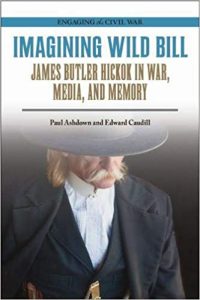New from the “Engaging the Civil War” Series: Imagining Wild Bill
 It’s always exciting when a new book arrives from the printer, but right now, it’s especially exciting. Since the onset of COVID, our Emerging Civil War books have been racked up like airplanes circling O’Hare Airport waiting out a Christmas Eve blizzard. To have one finally land after months of waiting makes this arrival doubly exciting!
It’s always exciting when a new book arrives from the printer, but right now, it’s especially exciting. Since the onset of COVID, our Emerging Civil War books have been racked up like airplanes circling O’Hare Airport waiting out a Christmas Eve blizzard. To have one finally land after months of waiting makes this arrival doubly exciting!
The latest book in our “Engaging the Civil War” Series, published in cooperation with Southern Illinois University Press, is now available: Imagining Wild Bill: James Butler Hickok in War, Media, and Memory by Paul Ashdown and Ed Caudill.
And check out David Wright, the ‘Wild West’ actor and producer who appears on the cover!
About Imagining Wild Bill:
When it came to the Wild West, the nineteenth-century press rarely let truth get in the way of a good story. James Butler “Wild Bill” Hickok’s story was no exception. Mythologized and sensationalized, Hickok was turned into the deadliest gunfighter of all, a so-called moral killer, a national phenomenon even while he was alive.
Rather than attempt to tease truth from fiction, coauthors Paul Ashdown and Edward Caudill investigate the ways in which Hickok embodied the culture of glamorized violence Americans embraced after the Civil War and examine the process of how his story emerged, evolved, and turned into a viral multimedia sensation full of the excitement, danger, and romance of the West.
Journalists, the coauthors demonstrate, invented “Wild Bill” Hickok, glorifying him as a civilizer. They inflated his body count and constructed his legend in the midst of an emerging celebrity culture that grew up around penny newspapers. His death by treachery, at a relatively young age, made the story tragic, and dime-store novelists took over where the press left off. Reimagined as entertainment, Hickok’s legend continued to enthrall Americans in literature, on radio, on television, and in the movies, and it still draws tourists to notorious Deadwood, South Dakota.
American culture often embraces myths that later become accepted as popular history. By investigating the allure and power of Hickok’s myth, Ashdown and Caudill explain how American journalism and popular culture have shaped the way Civil War–era figures are remembered and reveal how Americans have embraced violence as entertainment.
About the Authors:
Both Paul Ashdown and Edward Caudill are professors emeritus of journalism at the University of Tennessee, Knoxville. They have co-written Inventing Custer: The Making of an American Legend; Sherman’s March in Myth and Memory; The Myth of Nathan Bedford Forrest; and The Mosby Myth: A Confederate Hero in Life and Legend. Ashdown specializes in literary journalism, international communication, and popular culture, and Caudill focuses on media history, the Civil War era, and the history of ideas in public memory and the press.
Ashdown also has a particular expertise in the novel, history, and memory of Cold Mountain. Aside from his own work on that novel/movie, he wrote an essay about it for our pop culture book, Entertaining History: The Civil War in Literature, Film, and Song. He also did an appendix for Dan Davis’s ECWS bio on George Custer, The Most Desperate Acts of Gallantry: George A. Custer in the Civil War.
You can order Imagining Wild Bill from the Southern Illinois University Press website or Amazon.com.
First “gunfight” vs Davis Tutt in the square in the city where I was born – Springfield, MO. Gunfight took place in July 1865.